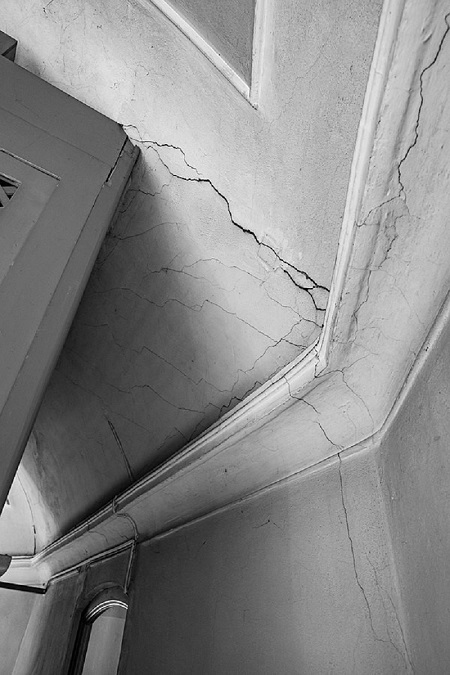Cracks in Nordic noir TV series
Cracks work on multiple levels when screened in Nordic noir television series and are never incidental. Visually, the crack draws the viewer in, providing a space of darkness and potential danger. Metaphorically, it can symbolise a large suite of problems, including the disintegration of the welfare state.

In keeping with the strong social democratic traditions of Scandinavian crime fiction, which often use a police detective’s internal illness (usually an ulcer) as a metaphor for the faltering folkhemmet or ‘people’s home’, the use of cracks and other faults in Norden’s built environments signifies the decay of the utopian welfare state.
Henning Mankell’s short story ‘Crack’ (Sprickan, 1999) literally employs a crack in the floor to interrogate the issue of violence as a ‘disruptive force’ that withers democracy and depletes the benefits of the welfare state. As a foundational text for contemporary Nordic noir television programming, The Bridge (Bron|Broen, 2011-2018) interrogated fault lines and failures of the Nordic way of life through the use of cracks, often highlighted by the dramatic use of light and darkness to evince what is (un)seen by making shadows a key focal point. The original ‘look book’, a textual-visual document that lays out the feel of a particular series before it is filmed, made the notion of cracks a central theme for the narrative. Siebling, Johansson and Sejer state in the 2010 look book for the series:
"The public institutions are like a worn out life-support system, the welfare state. We like the contrast between the apparently well-constructed and rational, and the decayed and many layers of ad hoc solution that been added over the years… The universe of The Bridge builds upon the idea of a carefully-constructed, well-thought-out world which is falling apart… A world in which the community has assumed a responsibility, but cannot handle it. The world is therefore about to crack.”
Metaphor for wider fissures in society
The worldwide acclaim for Scandinavian design, the cleanliness of public spaces and the orderliness of Nordic urban life all come under indictment via the visual representation of cracks, whether in the pavement, building façades, interpersonal relations or society-at-large.
The book series (and subsequent television adaptation) Dicte, which takes place in Denmark’s second largest city, Aarhus, actually began by highlighting the dangers of ‘cracks’. The first iteration of both, Skjulte fejl og mangler (novel, 2003; TV, 2013) translates as ‘hidden defects’, referring both to undiscovered faults in the foundation of crime reporter Dicte Svendsen’s recently-purchased house, but also as a “metaphor for her broken marriage and unstable relationship with her daughter”.
Dicte-author Elsebeth Egholm follows the Swedish crime author Håkan Nesser in using the theme of krackerelera (Swedish for ‘to fall apart’ or ‘lose control’) to highlight “psychological fissures.” Cracks are used to symbolise problems within what has been called “the glaze of everyday social interaction,” dividing the arena of the cosy (hygge in Danish) from societal constraint. This tension is common to the Scandinavian police procedural.
Conspicuous use of cracks
Cracks need not be so subtle. In the opening episode of the French-Swedish co-production Midnight Sun (2016- ), Chief Inspector Rutger Burlin (Peter Stormare) tutors his French counterpart on the history of Kiruna in arctic Sweden and the mine which has defined its economy for a century, stating: ‘A few years ago they found some dangerous cracks under the town but instead of closing the mine they decided to move the whole town’. ‘What do people think?’, she asks. Burlin’s response is: ‘Think? Who knows? Mommy [the mine] is their provider so without her, there’s nothing.’ At the end of the episode, the Swede will succumb to a poison in his system, meeting his end as he hallucinates a vision of a giant crevasse cascading across his town after a series of nightly controlled explosions at the mine (thus dramatically bringing together on screen the ‘sick detective’ with the ‘crack’). Later in the series, a Sami shaman instructs the lead detective that the culprit is ‘invisible, like a crack’, and to find that person, one must search for the edges. Herein the nåjd is arguing that the only way to find imperfection in a seemingly perfect space is to change one’s vantage point to allow shadows to reveal faults.
Beginning in a literary form, the crack – more so than the stomach ulcer – has successfully migrated to the screen, yet continues to bind Scandinavian crime fiction to Nordic noir television and film. As a trope, the crack works on multiple levels in Nordic noir. Visually, it draws the viewer in, providing a space of liminality, darkness and potential danger. Metaphorically, it can symbolise a large suite of problems, but especially those related to the dissipation of the dream of the well-oiled ‘people’s home’ that once provided security, prosperity and a sense of purpose to the peoples of Europe’s northern reaches.
Further reading:
- Robert A. Saunders, 'A Dark Imaginarium: The Bridge, Malmö, and the Making of a ‘Non-Existent’ Place', Journal of Urban Cultural Studies 4, 3 (2017), pp. 361-385.
- Charlotte Siebling, Jørgen Johansson, and Niels Sejer. The Bridge—A Dark Story: Visual Principles and Ideas (Stockholm: Filmlance International/Nimbus AB, 2010)
- Sylvia Söderlind, 'Håkan Nesser and the Third Way: of Loneliness, Alibis and Collateral Guilt' In Scandinavian Crime Fiction, edited by Andrew Nestingen and Paula Arvas, pp. 159-170 (Cardiff: University of Wales Press, 2011)
- Jakob Stougaard-Nielsen, Scandinavian Crime Fiction (New York: Bloomsbury Publishing, 2017)
- Kim Toft Hansen, 'Ambivalente fiktioner: Vold, den svenske uro og Henning Mankell' In Fingeraftryk: Studier i krimi og det kriminelle (Festskrift til Gunhild Agger), edited by Jørgen Riber Christensen and Kim Toft Hansen, pp. 239-255 (Aalborg: Aalborg Universitetsforlag, 2010)
- Kim Toft Hansen and Anne Marit Waade, Locating Nordic Noir: From Beck to The Bridge. (Basingstoke, UK: Palgrave, 2017)